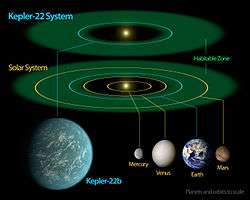Kepler-22
Kepler-22 is a sun-like star in the northern constellation of Cygnus, the swan, that is orbited by a planet found to be unequivocally within the star's habitable zone. It is located at the celestial coordinates: Right Ascension 19h 16m 52.2s, Declination +47° 53′ 4.2″.[6] With an apparent visual magnitude of 11.7,[3] this star is too faint to be seen with the naked eye. It can be viewed with a telescope having an aperture of at least 4 in (10 cm).[7] The estimated distance to Kepler-22 is 638 light-years (196 parsecs).[2]
 A diagram of the Kepler-22b System, compared to our Inner Solar System. | |
| Observation data Epoch J2000 Equinox J2000 | |
|---|---|
| Constellation | Cygnus[1] |
| Right ascension | 19h 16m 52.1904s[2] |
| Declination | +47° 53′ 03.948″[2] |
| Apparent magnitude (V) | 11.664[3] |
| Characteristics | |
| Spectral type | G5V[4] |
| Astrometry | |
| Proper motion (μ) | RA: −39.717±0.052[2] mas/yr Dec.: −66.687±0.046[2] mas/yr |
| Parallax (π) | 5.1088 ± 0.0242[2] mas |
| Distance | 638 ± 3 ly (195.7 ± 0.9 pc) |
| Absolute magnitude (MV) | ~5.27 |
| Absolute bolometric magnitude (Mbol) | ~4.98 |
| Details | |
| Mass | 0.970 ± 0.060[3] M☉ |
| Radius | 0.979 ± 0.020[3] R☉ |
| Luminosity | 0.79 ± 0.04[3] L☉ |
| Luminosity (bolometric) | 0.8 L☉ |
| Luminosity (visual, LV) | ~0.67 L☉ |
| Temperature | 5518 ± 44[3] K |
| Metallicity [Fe/H] | –0.29 ± 0.06[3] dex |
| Rotational velocity (v sin i) | 0.6 ± 1.0[3] km/s |
| Other designations | |
| Database references | |
| SIMBAD | data |
| KIC | data |
Kepler-22 is slightly smaller and cooler than the Sun,[8] with a lower abundance of elements having more mass than helium.[3] It has a spectral type of G5V, while the luminosity class remains undetermined.[4] This star is radiating 79%[3] of the Sun's luminosity from its outer atmosphere at an effective temperature of 5,518 K,[3] giving it the yellow-hued glow of a G-type star.[9] A projected rotational velocity of 0.6 km/s[3] suggests it has a low period of rotation.
Planetary system
On December 5, 2011, scientists from the Kepler mission announced that a possible Earthlike world (Kepler-22b) had been discovered orbiting in the star's habitable zone by NASA's Kepler spacecraft.[10] This was significant in that it was the first relatively Earth-sized extrasolar planet (about twice as big)[10] confirmed to be orbiting within a star's habitable zone.[11]
| Companion (in order from star) |
Mass | Semimajor axis (AU) |
Orbital period (days) |
Eccentricity | Inclination | Radius |
|---|---|---|---|---|---|---|
| b | < 0.11 MJ | 0.849 ± 0.018 | 289.8623 +0.016 −0.02 |
— | — | 2.4 R⊕ |
References
- "Cygnus – constellation boundary", The Constellations, International Astronomical Union, retrieved 2011-12-15
- Brown, A. G. A.; et al. (Gaia collaboration) (August 2018). "Gaia Data Release 2: Summary of the contents and survey properties". Astronomy & Astrophysics. 616. A1. arXiv:1804.09365. Bibcode:2018A&A...616A...1G. doi:10.1051/0004-6361/201833051. Gaia DR2 record for this source at VizieR.
- Kepler-22b, NASA Ames Research Center, retrieved 2011-12-06
- Schneider, Jean, "Star: Kepler-22", Extrasolar Planets Encyclopaedia, Paris Observatory, retrieved 2011-12-06
- "GSC 03546-02301 -- Star", SIMBAD, Centre de Données astronomiques de Strasbourg, retrieved 2011-12-08
- "Kepler Discoveries". 2011-12-05.
- Sherrod, P. Clay; Koed, Thomas L. (2003), A Complete Manual of Amateur Astronomy: Tools and Techniques for Astronomical Observations, Astronomy Series, Courier Dover Publications, p. 9, ISBN 0486428206
- "Kepler Confirms First Planet in Habitable Zone of Sun-Like Star". Universe Today. 2011-12-05.
- "The Colour of Stars", Australia Telescope, Outreach and Education, Commonwealth Scientific and Industrial Research Organisation, December 21, 2004, archived from the original on March 10, 2012, retrieved 2012-01-16
- Boyle, Rebecca (December 5, 2011). "Kepler Team Confirms First Earth-like planet in a habitable zone, And Finds 1,094 More Worlds". Popular Science. Retrieved December 5, 2011.
- "NASA Telescope Confirms Alien Planet in Habitable Zone". Space.com. 2011-12-05.